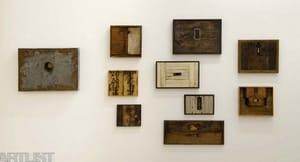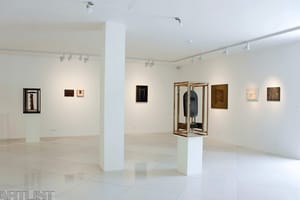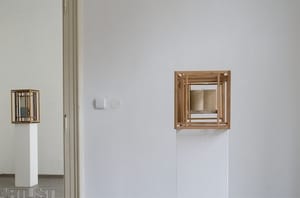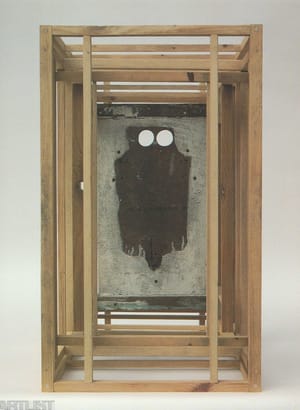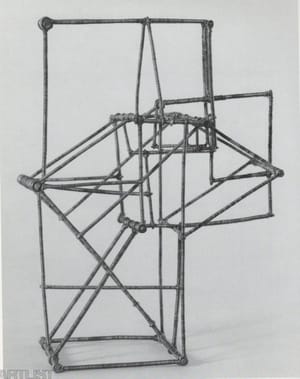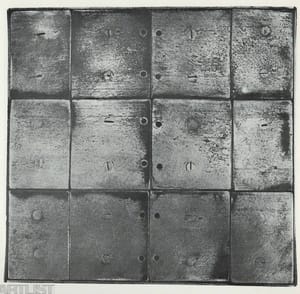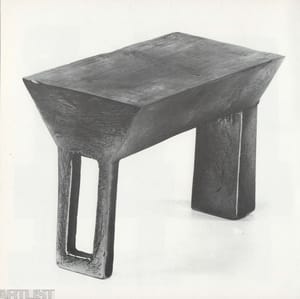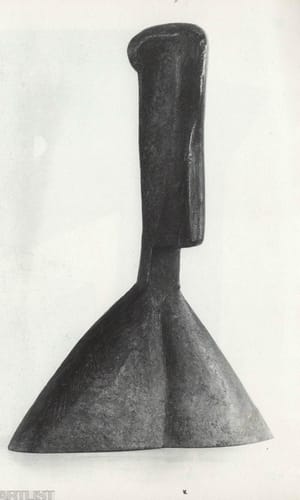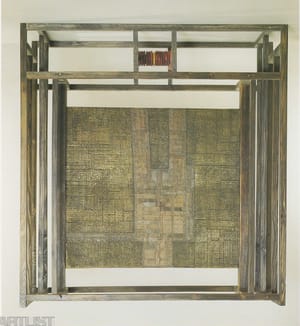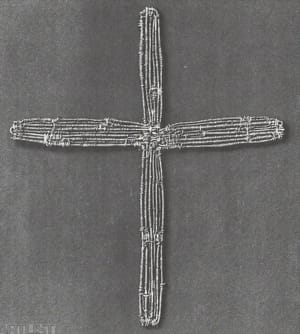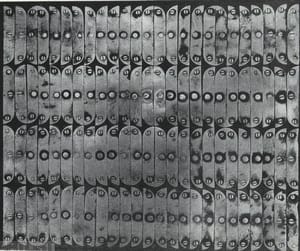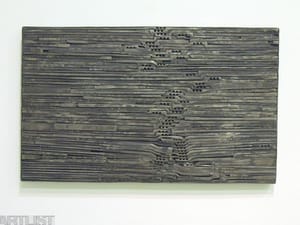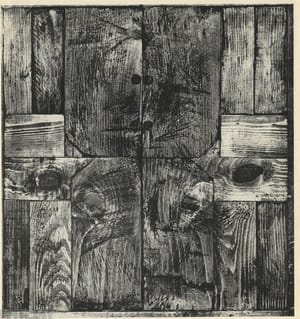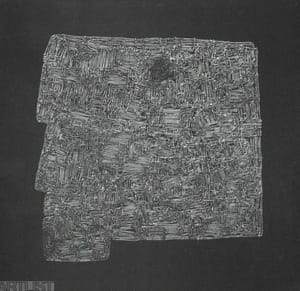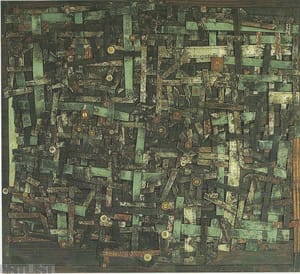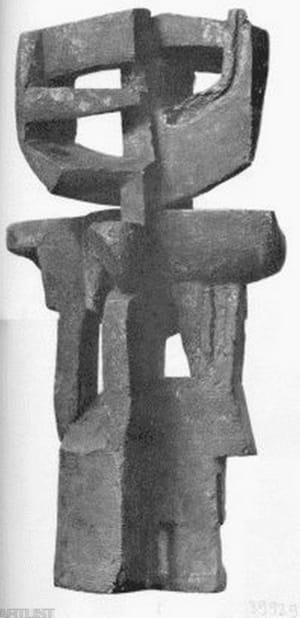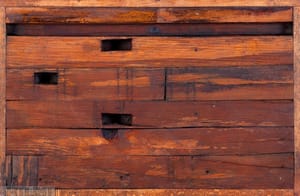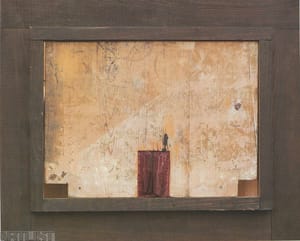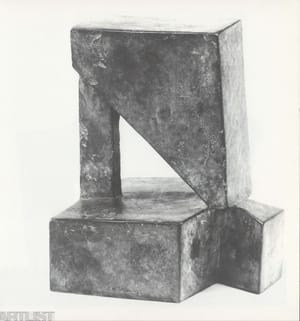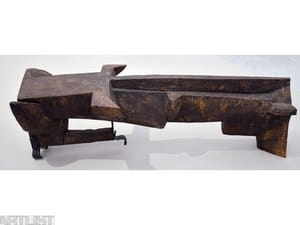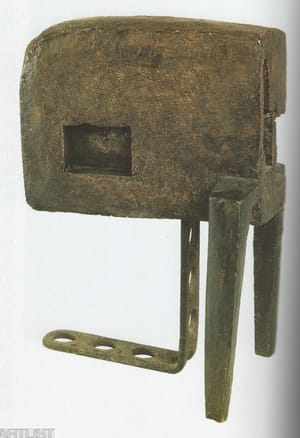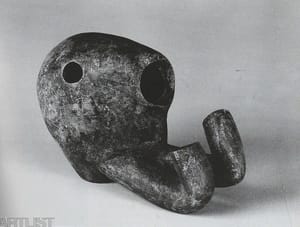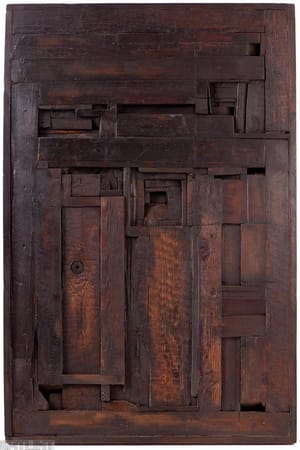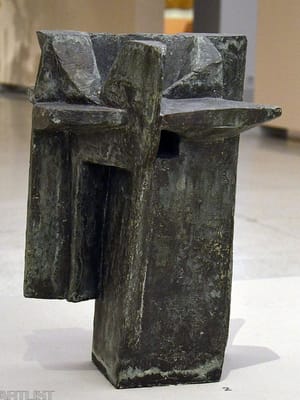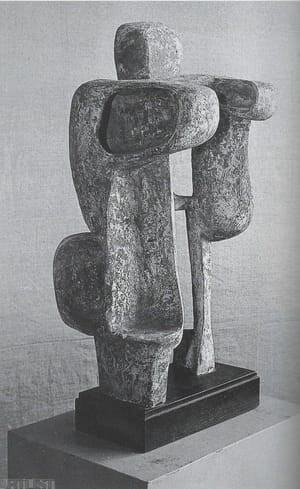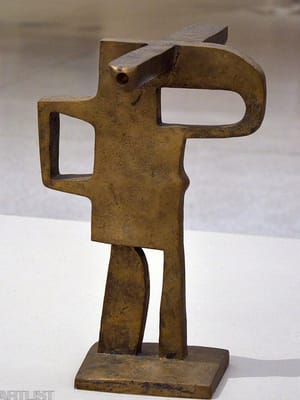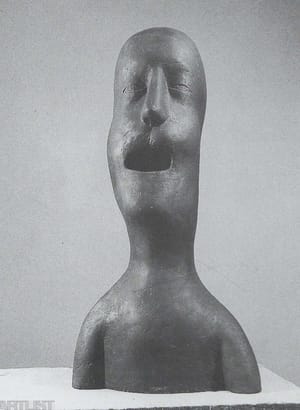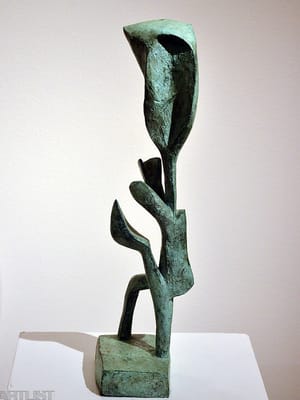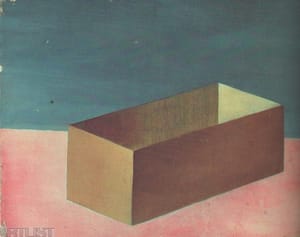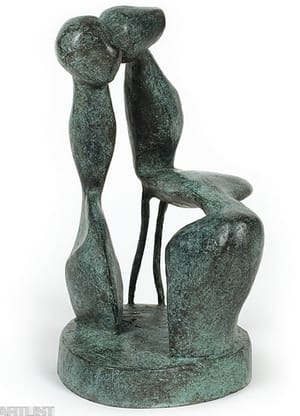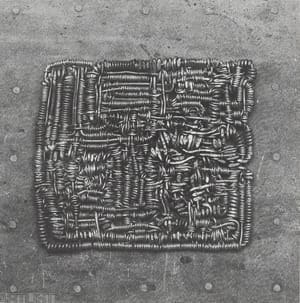- First Name
- Zbyněk
- Surname
- Sekal
- Born
- 1923
- Birth place
- Praha
- Place of work
- Praze, od 1970 ve Vídni
- Died
- 1998
- Lived and worked in
- Praha, Vídeň
- CSU Library
- ↳ Find in the catalogue
About artist
Zbyněk Sekal underwent a harsh experience while still a young man. When he was eighteen years old (in 1941) he was arrested by the Gestapo for activities as part of an illegal communist youth group and until the end of the war he was interned in the Terezín and Mathausen concentration camps. After the war he studied at the Academy of Arts, Architecture and Design (Vysoká uměleckoprůmyslová škola), where he made friends with Mikuláš Medek and Stanislav Podhrázský. At that time he also joined the Spořilov surrealist group. He never completed his studies. In 1950 he interrupted his studies and made a living in advertising and then as an editor at Svoboda Publishing House. In 1953 he moved to Bratislava and devoted himself to working on translating German texts. He returned to art in the mid-1950s. In 1958 he moved back to Prague. His work had a strong influence on the emerging young generation of artists leading Czech art out of the crisis caused by dictated Stalinist artistic norms. By that time Sekal was a distinctive figure in the art scene whose work was different from that of his peers.
Sekal’s beginnings as an artist coincided with the war. He expressed the harsh experiences he had during the war in art and as a student he came into contact with surrealism. He never orthodoxly embraced this movement, like some of his peers (Mikuláš Medek), and for Sekal surrealism, given its absurdist inclinations, represented a platform that allowed him to address persistent existential questions about the place of man in society. Surrealism thus open up a world of imagination for him, and after 1956 he began to introduce that into a world that consisted of simple, ordinary scenes, leading him to pursue a form of work that reflected the enigmatic realism of the new objectivity. Sekal’s interest in philosophy (which he also translated from German) added to the metaphysical-magical side of his work, an example of which is provided by his painting Little Box (Krabička, circa 1956).
At the same time Sekal also began working in sculpture. At a remove from the academic approaches to resolving the basic questions of sculpture and attempts to process the interwar avant-garde, as a solitaire Sekal modelled unconventional, summarising figurative heads (mainly heads and busts), which were infused with the contemporary sense of disquieting uncertainty and surviving feelings of trauma from the war (Shouting Head / Křičící hlava, 1957; Dead Head / Mrtvá hlava, 1957; Little Bird / Ptáček, 1957). Around 1958 Sekal began moving towards a more abstract form of expression: his sculptures from the series Abode (Obydlí) and Signalling (Návěstí) range from soft contructivist forms to imaginatively absurdist hybrids. (Is it a figure? A geometric construction? Or a surreally constructed dream journal?). Sekal’s work from around the years 1958-1962 is filled with shapes welded together and brought into harmony. It was at the end of this period, for instance, that he created his very abstract sculptures Armchair (Křeslo, 1962) and Head (Hlava, 1963), which reveal him to have been undergoing an unprecedented radicalisation at that time in the sense of freeing shapes into a simple geometric (but not constructivist) forms. Sekal did not, however, continue in this direction, because for a sensitive and existentially preoccupied nature such as his it produced something too cool and exclusive of meaningful contexts.
As well as sculpture, Sekal’s art also began to feature work in paper (using the collage technique, another echo of surrealism) and hanging assemblage objects, in which the artist arranged, interwove, and overlapped found objects, which he understood as inscribed with the hidden traces of human existence (Operational Scheme / Schéma provozu, 1964; Lock-Ups / Zamyky, 1964).
In 1967–1968 Sekal arrived at a more serial, more surveyable arrangement of objects, particularly making use of wood (Whoever / Kdokoli, 1967; To the Right, Please / Doprava, prosím, 1968). At this time another major turning point in the artist’s life was approaching. In January 1969 Sekal exhibited work at Špála Gallery, headed by Jindřich Chalupecký (who in the introduction to the catalogue described Sekal’s work as hard to define), but at the end of 1969 left for Western Berlin (having received a Daad fellowship) and he did not come back. After several months in Germany as an émigré, in September 1970 he settled in Vienna and remained there for the rest of his life.
The 1970s were the years when hanging objects became the focus of his work. Along with wood, metal became a favoured material. Sekal would nail iron plates, strips of metal and prefabricated metal components onto panels of wood. The result would be a kind of quasi-ornamental play on shapes in which a role was also played by the hammered nail heads which were left visible. There is a tension here spreading from the simple, almost geometric shapes (almost starkly linked up with each other in a series), and even a strange imperfection or sense of something not being carried to the point of perfection. Moving between these two extremes at once generates a feeling of something transcendental that cannot be described or grasped. In the 1970s Sekal’s work also included objects created out of copper and brass wires laboriously roll up and woven together and stretched out like endless labyrinths across wooden panels (Head / Hlava, 1969-79 and 1972-73). Sekal usually worked on these exhaustingly painstaking wire objects for a long time and some of them were completed or created in the 1980s.
Alongside these hanging, complexly shaped objects Sekal also focused on three-dimensional sculpture. In this area he was essentially elaborating on his artistic outlook from the early 1960s, though after emigrating his sculptures became less heavily existentialist and more concisely simplified in form. The formal ambiguity, however, did not fade: the artist continued to play with the ambivalence between what is depicted and what is not depicted, or the abstract. Sometimes the figurative form is more apparent (Bust / Busta, 1973), other times the guideline to tangibility is found in the title (Table / Stůl, 1973).
In the 1980s Sekal rather more dramatically altered his style, but only on the formal level. He began creating cube-like cages and transparent chests hammered together out of laths. And as before, while the form is geometric, the imperfection of detail renders the overall tone of the object remote from any abstract-geometric tendencies. Moreover the cage-like chests usually ‘conceal’ some kind of object – it is visible but at the same time inaccessible, so the impression is that is some kind of rare and mysterious relic-like object. The artist pursued this line of work in the 1990s. In addition to them there were also his complicated three-dimensional objects made of wire reminiscent on one hand of a cage or chest and on the other of labyrinths or a kind of puzzle.
Perhaps these late cage-like works and labyrinthine weavings of wire and laths can stand as a symbol of all of Sekal’s work. For him (like for any philosophically minded person) life was a constant mystery. On the one hand, humans are able to explain (and even direct) all kinds of things, but on the other hand they are dragged into the unknown. The latter happened to Sekal many times: during the war, in the 1950s and the 1960s and when he emigrated). It is hard to say whether Sekal’s extreme experiences brought him to ‘the roots of true existence’, as postulated in existential philosophy. One thing however can be said: Sekal, artist and philosopher, introduced a very powerful element of human philosophy into Czech post-war art. The parallel with post-war existentialism in Sekal’s work is however a loose one: his was not a concept of existentialism in the sense of Sartre. Despite all the questions about the meaning of human existence and despite being absurdly thrust into a tangled mass of insurmountable situations, the humans in Sekal’s work seem be at terms with all the forms of their existence. Sekal’s labyrinths and chests form a permanent part of our life: they are naturally present in it. That is what makes humans human.
- Author of the annotation
- Ivona Raimanová
- Published
- 2015
CV
Studia: 1945 – 1950 VŠUP Praha (bez dokončení) 1972-1974 Staatliche Akademie der Bildenden Künste Stuttgart , Stuttgart (profesor) Ceny:
1984 – cena Města Vídně za sochařství Studijní pobyty: 1969 – DAAD Berlin
- Member of art groups included in ARTLIST.
- Member of art groups not included in ARTLIST.
- 1974 – Wiener Secession
Exhibitions
- Solo exhibitions
-
2013 Zbyněk Sekal & Jindřich Zeithamml, Galerie Závodný, Mikulov
2012 Skládané obrazy a schránky, Topičův salon, Praha
2010 Skládané obrazy, sochy a schránky, Brno Gallery CZ, Brno
2003 Plastiky a reliéfy 1959 - 1994, Galerie Ztichlá klika, Praha, Galerie Caesar, Olomouc
1997 Práce za posledních pětapadesát let / Arbeiten aus den letzten fünfundfünfzig Jahren, Městská knihovna, Praha
1992/93 Některé práce z let 1940 - 1992, Dům umění města Brna, Dům umění v Opavě, Galéria Médium, Bratislava
1992 Skulpturen, Materialbilder, Zeichnungen, Gerüste 1967 - 1991, Künstlerhaus Klagenfurt
1991 Scultore, Studio oni de Rossi, Verona
1991 Rupertinum, Salzburg
1990 Galerie Stubenbastei, Vídeň
1988 Bronzek, Zeichnungen, Neue Galerie, Wien, Vídeň
1982, 1985, 1987 Geflechte Anwendungen eines Verfahrens, Neue Galerie, Vídeň
1977 Zusammengesetzte Bilder, Zeichnungen, Neue Galerie des Landesmuseum Joanneum in Graz, Museum Bochum, Museum Moderner Kunst, Vídeň
1971 Bilder und Skulpturen, Galerie im Griechenbeisl, Vídeň
1969 Skládané obrazy a sochy, Galerie Václava Špály, Praha
1965 Sochy - reliéfy: 1948 - 1965, Dům pánů z Kunštátu, Brno
1965 Galerie Václava Špály, Praha
- Group exhibitions not included in ARTLIST.
-
2012/13 Československý filmový plakát 1959–1989, Wortnerův dům Alšovy jihočeské galerie, České Budějovice
2012 Od Tiziana po Warhola: Muzeum umění Olomouc 1951–2011
2012 České moderní umění, Galerie výtvarného umění v Chebu
2010 Roky ve dnech. České umění 1945–1957, GHMP, Městská knihovna, Praha
2010 Realita je víc než fikce: Asambláž jako tvůrčí princip v českém umění 60. a 70. let, Dům pánů z Kunštátu, Brno
2010 New Sensitivity, National Art Museum of China, Beijing
2010 České umění v exilu / Tschechische Kunst im Exil Wien, Galerie G, Olomouc
2010 Česká koláž ze sbírky Pražské plynárenské, Galerie Smečky, Praha
2008/09 České a slovenské umění 60. let 20. století, Trenčín, Liptovský Mikuláš, Zlín, Ostrava
2008 Nechci v kleci! / No cage for me!, Muzeum umění Olomouc
2008 Na zkoušku v ráji? Umění šedesátých let ze sbírek Západočeské galerie v Plzni, Výstavní síň „13“, Plzeň
2007/8 Soustředěný pohled / Focused View. Grafika 60. let ze sbírek členských galerií Rady galerií České republiky, Oblastní galerie v Liberci, Liberec (Liberec), Oblastní galerie Vysočiny v Jihlavě
2007 Skupina Máj 57, Pražský hrad, Císařská konírna, Praha
2004/06 Šedesátá / The sixties, Ze sbírky Galerie Zlatá husa v Praze, Dům umění města Brna, Galerie umění Karlovy Vary
2003 Umění je abstrakce. Česká vizuální kultura 60. let, Jízdárna Pražského hradu, Uměleckoprůmyslové muzeum, Brno, Salon, Kabinet, Olomouc
2002/04 Svět hvězd a iluzí. Český filmový plakát 20. století, Moravská galerie v Brně, Mánes, Praha, České centrum New York, České centrum Londýn, Generální konzulát České republiky, Los Angeles, České kultúrné centrum, Bratislava, České centrum Drážďany, Generální konzulát České republiky, Hongkong, Galerie umění Karlovy Vary, Macao Museum of Art
2001/02 Objekt - objekt: Metamorfózy v čase / Object - object: Metamorphoses in time, Dům U Černé Matky Boží, Praha, Pražákův palác, Brno
2001 Bilance II, Obrazy a sochy, Galerie umění Karlovy Vary
1999 Umění zrychleného času. Česká výtvarná scéna 1958 - 1968, Praha, Cheb
1997 Aspekte imaginativer Kunst im 20. Jahrhundert: Profil und Perspektiven einer Sammlung, Museum Bochum, Kunstverein Gütersloh
1997 České imaginativní umění, Galerie Rudolfinum, Praha
1994 Šedá cihla 66/1994 Exil, Galerie U Bílého jednorožce, Klatovy
1994 Ohniska znovuzrození, GHMP, Městská knihovna, Praha
1993/94 Záznam nejrozmanitějších faktorů… České malířství 2. poloviny 20. století ze sbírek státních galerií, Jízdárna Pražského hradu
1993 České výtvarné umění 1930–1960, České muzeum výtvarných umění, Praha
1992 České výtvarné umění 1960–1990, Středočeská galerie, Praha
1991 Český informel. Průkopníci abstrakce z let 1957–1964, GHMP, Praha
1991 Studio Toni de Rossi, Verona
1991 Rupertinum, Salzburg
1990 Polymorphie: Kunst als subversives Element Tschechoslowakei 1939–1990, Martin-Gropius-Bau, Berlín
1990 Galerie Stubenbastei, Wien
1989 Wo bleibst du, Revolution?, Museum Bochum, Bochum
1983/84 Das Prinzip Hoffnung. Aspekte der Utopie in der Kunst und Kultur des 20. Jahrhunderts, Museum Bochum
1982 Künstler, Die kamen und blieben, Secession, Wien
1980 Die Kunst Osteuropas im 20. Jahrhundert, Garmisch-Partenkirchen
1976 Parallelaktion, Neue Kunst aus Östereich, Von der Heydt Museum, Wuppertal
1974 Wiener Secession, Krems
1974 Tschechische Künstler, Galerie Wendtorf + Swetec, Düsseldorf
1974 Neue Mitglieder der Wiener Secession, Wien
1971 Imago, Galerie im Greichenbeisl, Schloss Lengenfeld
1970 Tschechische Skulptur des 20. Jahrhunderts: Von Myslbek bis zur Gegenwart, Schloß Charlottenburg - Orangerie, Berlín
1969 L'art tcheque actuel, Renault Champs - Élysées, Paříž
1969 Arte contemporanea in Cecoslovacchia, Galleria Nazionale d'Arte Moderna e Contemporanea (GNAM), Řím
1968 Socha piešťanských parkov '68, Piešťany
1968 Sculpture tchècoslovaque de Myslbek à nos jours, Musée Rodin, Paříž
1968 Nové věci, Galerie Václava Špály, Praha
1968 Deset sochařských vyznání, Galerie Fronta, Praha
1968 300 malířů, sochařů, grafiků 5 generací k 50 létům republiky, Praha
1967 Obraz 67. Celostátní výstava současné malířské tvorby, Uměleckoprůmyslové muzeum, Brno
1967 Mostra d'arte contemporanea cecoslovacca, Castello del Valentino, Turín
1967 Moderne Kunst aus Prag, Celle, Soest, Kunsthalle zu Kiel
1967 17 tsjechische kunstenaars (17 českých umělců), Galerie Orez, Den Haag
1966 Tschechoslowakische Plastik von 1900 bis zur Gegenwart, Museum Folkwang, Essen
1966 Tschechoslowakische Kunst der Gegenwart, Akademie der Künste, Berlín
1966 Tokyo International Exhibition of Art, Tokyo
1966 Nové cesty: Přehlídka současné avantgardy, Dům umění, Zlín
1966 Jarní výstava 1966, Mánes, Praha
1966 Aktuální tendence českého umění. Obrazy, sochy, grafika, Galerie Václava Špály, Praha
1965 Tschechoslowakische Kunst heute: Profile V, Städtische Kunstgalerie, Bochum
1965 Sochařská bilance 1955–1965, Olomouc
1965 Objekt, Galerie Václava Špály, Praha
1965 Małarstwo a rzeźba z Pragi, Krakov
1965 La transfiguration de l'art tcfhéque: Peinture - sculpture - verre - collages, Palais de Congres, Liege
1965 Keramik aus 12 ländern, Internationaler Künstlerclub IKC (Palais Pálffy), Vídeň
1965 Grafika 65, Vlastivědné museum, Písek
1964 Výstava D, Galerie Nová síň, Praha
1964 Tvůrčí skupina Máj, Galerie Nová síň, Praha
1964 Socha 1964, Liberec
1963 Umění 1900–1963, Alšova jihočeská galerie v Hluboké nad Vltavou
1961 Tvůrčí skupina Máj, Poděbrady
1961 Nejkrásnější knihy roku 1960, VŠUP, Praha
1958/59 Umění mladých výtvarníků Československa 1958. Obrazy a plastiky, Jízdárna Pražského hradu, Dům umění města Brna
1958 2. výstava Skupiny Máj 57, Palác Dunaj, Praha, Varšava
1957 Mladé umění / Tvůrčí skupina Máj 57, Obecní dům, Praha
- Collections
- Alšova jihočeská galerie v Hluboké nad Vltavou, Hluboká nad Vltavou (České Budějovice) České muzeum výtvarných umění, Praha Galerie Benedikta Rejta, Louny (Louny) Galerie hlavního města Prahy, Praha Galerie umění Karlovy Vary, Karlovy Vary (Karlovy Vary) Galerie výtvarného umění, Roudnice nad Labem (Litoměřice) Galerie výtvarného umění v Chebu, Cheb (Cheb) Generali Foundation, Vídeň (Wien) Moravská galerie v Brně, Brno (Brno-město) Museum Bochum, Bochum Museum des 20. Jahrhunderts (20er Haus) / Museum Moderner Kunst, Vídeň (Wien) Národní galerie v Praze, Praha Rupertinum, Salzburg
- Other realisations
Sympozia 1967 sochařské sympozium, Vyšné Ružbachy 1966 sochařské sympozium, St. Margarethen (Rakousko) 1964 a 1965 sochařské sympozium, Gmunden (Rakousko)
Monography
- Monography
Zbyněk Sekal: Práce za posledních pětapadesát let, text: H.Baumann,W. Hofmann, M.Klimešová, Z. Sekal, GHMP, Praha 1997 1992 Zbyněk Sekal: Některé práce z let 1940 – 1992,text: W. Hofmann, Z. Sekal, J. Valoch, Dům umění města Brna, 1992 1991 Sekal: scultore, S. Martini, Z.Sekal, Studio oni de Rossi, Verona, 1991 1988 Zbyněk Sekal: Bronzen, Zeichnungen, Neue Galerie, Wien, 1988 1982 Zbyněk Sekal: Geflechte Anwendungen eines Verfahrens, Neue Galerie, Wien 1982 1977 Zbyněk Sekal: Zusammengesetzte Bilder (Zeichnungen), Graz 1977 1971 Zbyněk Sekal: Bilder und Skulpturen, Travaux R, Vídeň 1971 1969 Zbyněk Sekal: Skládané obrazy a sochy, Text: J.Chalupecký SČVU, Praha 1969 1968 Zbyněk Sekal, Skládané obrazy, Divadlo za branou, 1968 1965 Zbyněk Sekal: Sochy - reliéfy 1948 – 1965, text: J. Kříž, SČVU, Praha 1965 Další literatura M. Klimešová, Pozdrav daleké země, pozdrav daleké zemi. Zbyněk Sekal a Japonsko, Arbor vitae, Řevnice 2014 New Sensitivity / Nová citlivost, Czech Sculpture of the 1960s - 1980s / České sochařství 60. - 80. let 20. století, M. Knížák a kol., NG v Praze 2010 M. Klimešová, Roky ve dnech, České umění 1945 – 1957, GHMP, Praha 2010 Šedesátá / The sixties, M. Juříková, V. Železný, Galerie Zlatá husa, Praha 2004 České umění 1938–1989, Programy, kritické texty, dokumenty, P. Morganová ed., Academia Praha 2001 M. Nešlehová, Poselství jiného výrazu, Pojetí informelu v českém umění 50. a první poloviny 60. let, Artefact a BASE, 1997 Nové umění v Čechách, J. Chalupecký, M. Nešlehová, H&H, s.r.o., Jinočany 1994 Ohniska znovuzrození, České umění 1956 – 1963, GHMP, Praha 1994 M. Nešlehová ad., Český informel, Průkopníci abstrakce z let 1957 – 1964, GHMP, Praha 1991 Wo bleibst du, Revolution?, Museum Bochum 1998 Sensibilités contemporaines / Contemporary artistic sensibilities, 70 artistes d'origine tchégue et slovaque hors tchécoslovaquie / 70 artists of Czech and Slovak origin living outside Czechoslovakia 1970 – 1984, G. Bénamou, Geneviève Bénamou, Paříž 1985 Aktuální tendence českého umění / Tendances actuelles de l'art tchéque, M. Míčko, AICA, Praha1966 Tschechoslowakische Kunst Heute – Profile,Städtische Kunstgalerie, Bochum 1965
